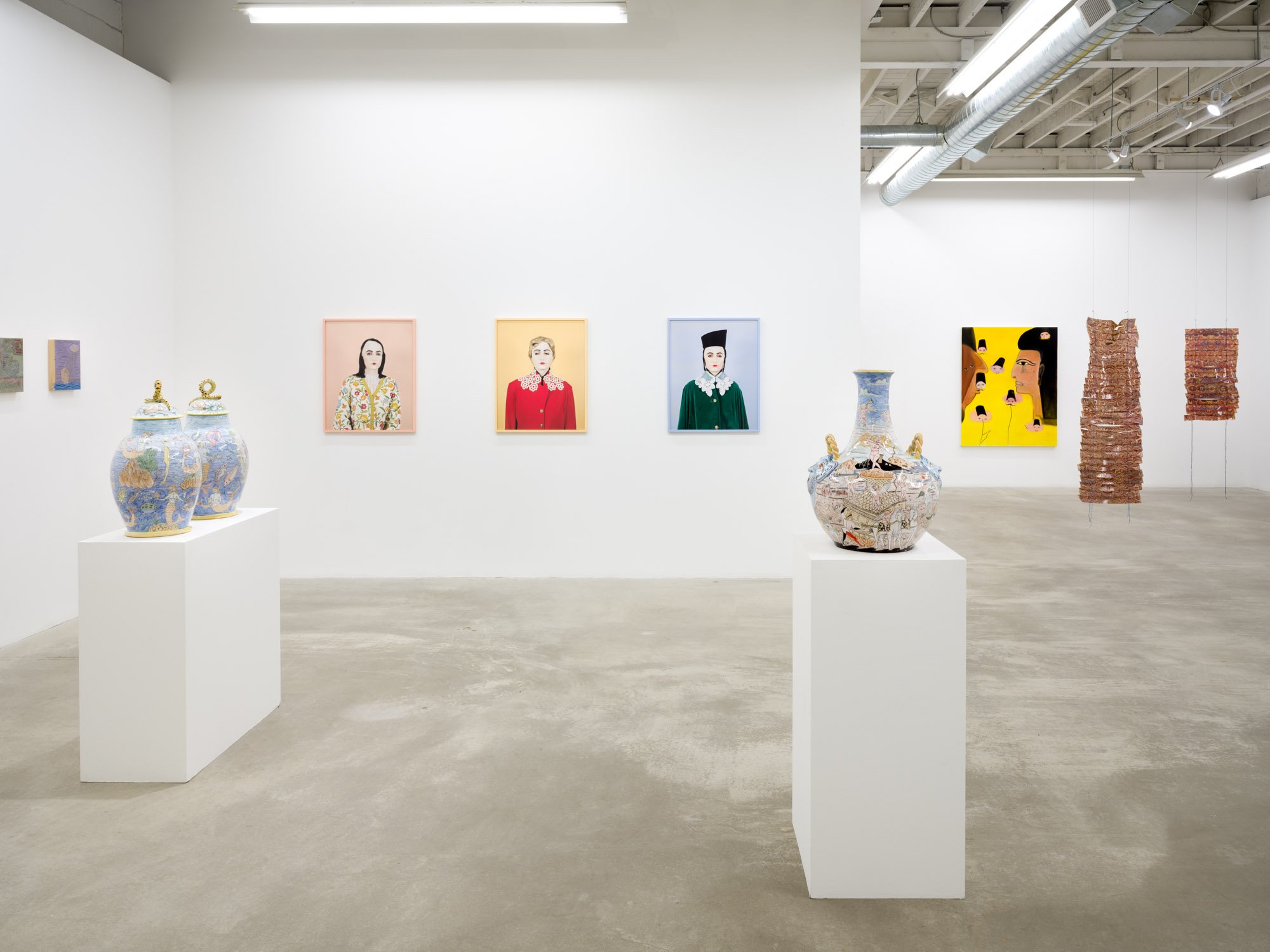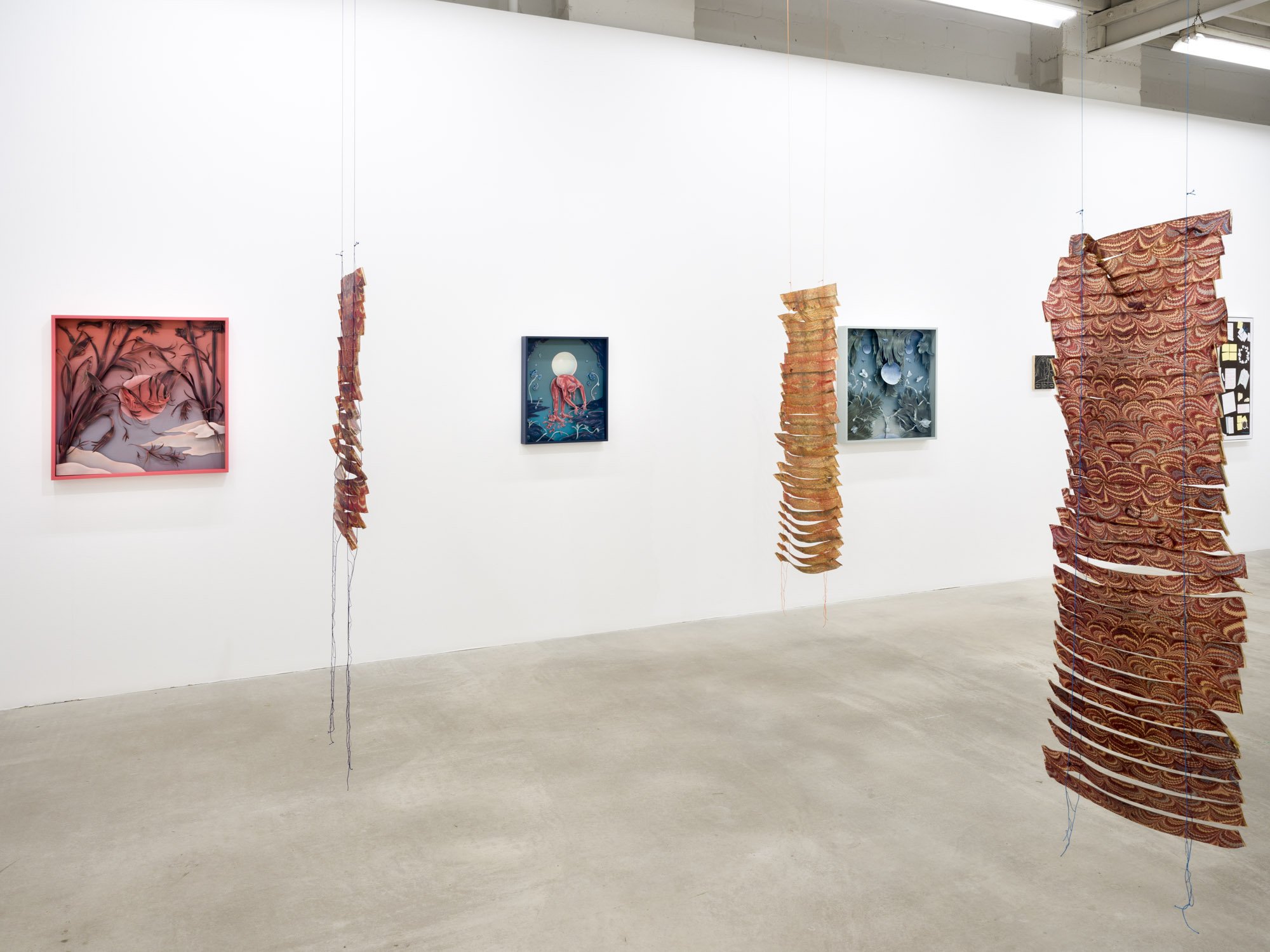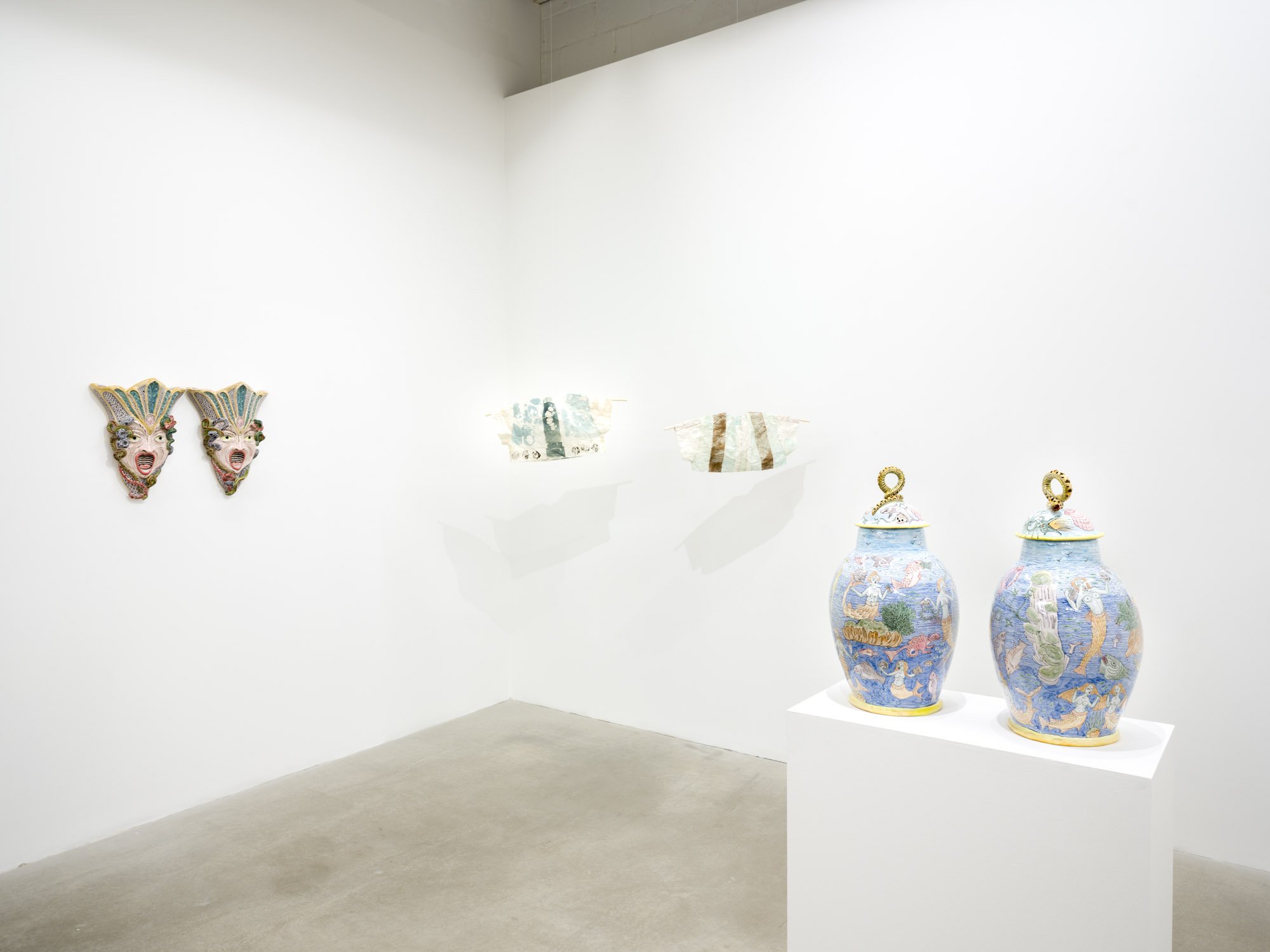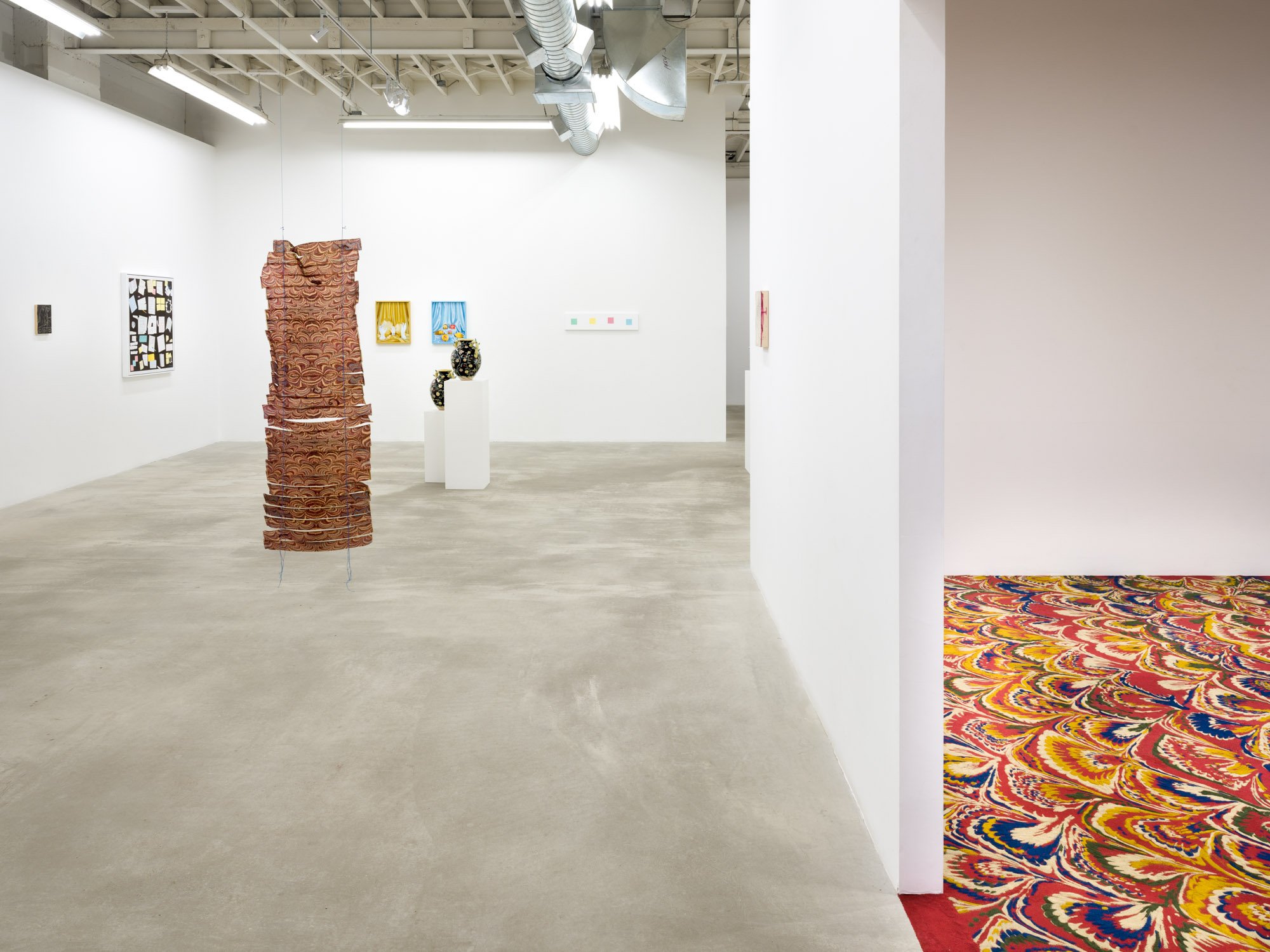21 WADE AVE #2 | TORONTO
surface temperature
9 MAR - 29 APR 2023
Surface Temperature
This fortuitous grouping of artists offers a relevant snapshot of how contemporary artists digest and challenge our understanding of being and creating. Collectively, these works take an interest in diverse, even, divergent themes, addressing immigration, decoration, productivism, capitalism, folklore, gender identity, architecture, intergenerational trauma, and mysticism, among others. Works in this exhibition offer unexpected correlations to reveal how these seemingly disparate themes overlap and commingle in the messy and magnificent stew of human existence. With no interest in ignoring or side-stepping history or legacy, works in this exhibition appear confident, comfortable, and reverent in where we find ourselves now — unafraid to tackle what’s going to come, equipped with redemptive perspectives.
Works in Surface Temperature exhibit notes of romanticism, present in strategic sentimentalism or symbolism (a lonely moon hangs in the distance) and the reclaiming of histories, myths, and beauty. This romanticism doesn’t appear starry-eyed or naive but, instead, sure-footed in the new narratives. For example, works in this exhibition by Ibrahim Abusitta appear mythologically cryptic. With interest in distorting time and memory, Abusitta’s work frequently results in a puzzling feeling of longing; yet, it isn’t clear what or who the longing is for. His particular brand of paired-down symbolism of heads, moons, and trees hints not only at a larger narrative that we aren’t privy to but something folkloric or supernatural. Also looking to the extraordinary, Winnie Truong animates her femme-presenting ‘Wimmin’ creatures to challenge the ideals of beauty and autonomy in relation to the female form. Truong also conjures imagery of the moon to connect the bodily to something celestial, underscoring ideas of connectivity and the unknowable. A celebration of something inherently other, beautiful, and strange.
Similarly, Shirin Fathi uses the body as medium to agitate ideas of gender identity via her “Heart Throbs” series, specifically focusing on the history of gender representation via the cultural exchange of Europe and Iran in the 19th century. Fathi’s visually striking series shows updated “royal” portraits as a nod to Iranian history that once embraced non-binary gender representation. Taping into the gendered history of porcelain and earthenware, Lindsay Montgomery creates personal mythologies that address topics of death, mysticism, feminism, and evolving modes of power. Within her work, Montgomery playfully leans on the ancient craft as one of the oldest methods of storytelling, to tell new, feminist perspectives about current issues, and challenges defunct ideas that the decorative and the political can’t coexist.
Surface Temperature foregrounds how artists are mobilizing their own traditions, histories, and materials to make them new. Moreso, they are pushing and questioning the fortitude of their chosen mediums as platforms to hold up their viewpoints and to reveal novel ways of thinking and making. Muriel Ahmarani Jaouich questions, “can painting withstand the ability to enable an empathic experience of muted trauma?”. Ahmarani Jaouich creates narratives based on her familial history, one of diaspora, immigration, and genocide, and looks to the history of painting to see if it can withstand the weight of such trauma and historical violence. Works in this group show aim to dismantle outdated archetypes and power imbalances by taking what might be seen as fragile or delicate and imbuing it with something scrappy, proud, and hardy. Or, taking something with deep roots in tradition, and making them new, as Alexa Hatanaka does via her series of paper-based garments that incorporate historic printmaking and washi crafts. With this series, Hatanaka engages in traditional and environmentally sustainable processes connected to her Japanese heritage to process relational experiences, personal growth, and memory. Differing from past iterations, Hatanaka's works in Surface Temperature offer a more contemporary silhouette patterned after a crop top, creating a direct connection between current fashion trends and more conventional processes of making. Furthermore, the usability of her works isn't hypothetical; certain iterations of Hatanaka's works, including the garment that inspired the original pattern, have been worn by the artist and her friends, adding an additional layer of personal significance. Shannon Garden-Smith’s architectural interventions utilize unconventional materials such as gelatin, gifted-jewellery, and sand to investigate the hidden politics of domestic and architectural forms we frequently encounter and the scarcity of resources we have come to think of as ubiquitous. Mimicking blinds and other vaguely domestic forms, her work creates suggested boundaries and thresholds to discuss consumption, poetics of space, and what is visible, invisible, decorative, or strategic. Garden-Smith’s recent work focuses specifically on our contemporary usage of sand, “a substance that connects with magic as much as with the mundane”; a material that is perplexingly becoming in shorter supply.
In Surface Temperature, an undertone of playfulness creates a sense of levity despite the weighty topics the respective works address. Some works in the exhibition utilize a buoyant, poppy, or glossy aesthetic to highlight the absurdity (and injustices) of the systems and structures we find ourselves currently governed by, including Shellie Zhang, whose work is interested in how culture is learned and sustained. Zhang’s series I’m a Material Girl but Indifference is the Product of Social Excess uses the sleek visual language of commercial staging to explore how cultural objects and iconographies are remembered and preserved, specifically through the lens of capitalism, mass communication, and language. Commissioned by the Art Gallery of Ontario, this work took influence from the Thomson Collection’s miniature objects and curiosities—a display featuring precious items intertwined with centuries of the cultural politics, taste and class. Michael Dumontier and Neil Farber’s longstanding collaboration frequently produces sharp moments of optimism and melancholy by mobilizing language, graphic gestures, and humor. Dumontier and Farber’s work Read This positions viewers to be unwitting performers by prompting the out-loud reading of their works with specific directorial cues on how and when to read certain elements. Pulling from Dadaist traditions, their work playfully addresses feelings of disillusionment and futility with the state of the world, validating that absurdist humor remains a culturally-significant way to digest what has transpired and what is to come.
- Jenna Faye Powell
Ibrahim Abusitta is a Palestinian-Canadian visual artist that lives and works in Toronto. He graduated from the Fine Art Photography program at OCAD U. After graduating, his practice shifted from photography as he evolved into a self-taught painter. Ibrahim’s paintings delve into themes of colour, texture, memory and time. Most recently, he was a contributor to Canadian Art Magazine on the discussion of BIPOC representation in Toronto’s commercial art galleries.
Winnie Truong is a Toronto artist working with drawing and animation to explore ideas of identity, feminism, and fantasy and finding its connections and transgressions in the natural world. She has exhibited her work internationally and was a 2017 recipient of the Chalmers Arts Fellowship. Her work has been included on the CBC program The Exhibitionists, and in her recent survey exhibition at Saw Gallery in Ottawa (ON). She has been an artist in residence at the Brucebo Scholarship in Gotland (Sweden) and a past resident at Doris McCarthy Fool’s Paradise in Scarborough (Ontario). Truong received her BFA from OCADUniversity.
Shirin Fathi is an Iranian Canadian multi-disciplinary artist and curator based in London. Her practice focuses on cultural changes in relation to gender identity. Through role-play and the use of cosmetics, masks, and prosthetics, she uses her body as a subject to stage ambiguous and often marginalized identities. Building upon her recent project focusing on gender representation in the history of cultural exchange between Europe and Iran in 19th century Qajar paintings, her practice examines gender representation in relation to the contemporary culture and beauty ideals imposed on Iranian women through cosmetic surgery. Shirin Fathi is currently a resident artist at Sarabande Foundation established by Lee Alexander McQueen. Her work has been featured in the Guardian, BBC, the Observer, the i and the British Journal of Photography. She has shown her work most recently at the new Centre for British Photography in the Headstrong: Women and Empowerment exhibition.
Lindsay Montgomery works across a variety of media including ceramics, painting and puppetry to create objects, and performances. Her work is focused on creating mythologies that confront and re-imagine classical narratives to address a wide range of topics and issues including death and mysticism, feminism, and evolving modes of power. Montgomery’s work has been exhibited in Canada and internationally with exhibitions at The Gardiner Museum for Ceramics, The Archie Bray Foundation, the Art Gallery of Nova Scotia, and multiple exhibitions through The National Conference on Education in the Ceramic Arts. She is the recipient of numerous awards including The Winifred Shantz Award for Ceramics, The Helen Copeland Memorial Award, The Joyce Carlyle Memorial Scholarship in the Crafts Endowment.
Muriel Ahmarani Jaouich is a Canadian artist of Armenian, Egyptian, and Lebanese descent, whose paintings focus on genealogy, intergenerational trauma and historical violence. Ahmarani Jaouich creates a narrative based on the history of her family; one of diaspora, immigration, and genocide. Her research is based on oral histories, photographic archives and objects bequeathed to her. Ahmarani Jaouich believes that dealing with undigested anguish of our ancestors frees us to live our present lives. In turn, it can also relieve ancestral suffering in the other world. Muriel Ahmarani Jaouich is currently living on the unceded indigenous lands of Tiohtià:ke / Montreal, QC, Canada, of the Kanien’kehà:ka Peoples. She is the recipient of the Lilian Vineberg scholarship, the Merit scholarship as well as the Tom Hopkins Memorial award.
Alexa Hatanaka engages in time-intensive, historic processes connected to her Japanese heritage that support her thinking around community-building, environment, and honouring evolving cultural practices such as relief-printmaking, papermaking and kamiko, the practice of sewing garments out of konnyaku starch-strengthened washi (Japanese paper). Her seminal work “Hazmat Suit (unborn/ reborn tsunami)” was acquired by the National Gallery of Canada in 2021 and is exhibited in the contemporary gallery. Her individually and collaboratively authored work has been exhibited at the Art Gallery of Ontario, Toronto; the British Museum and Canada House in London; the Toronto Biennial of Art; the Guanlan International Printmaking Base, Shenzen, China; and the Nikkei National Museum, Burnaby, British Columbia.
Shannon Garden-Smith (she/her) is an uninvited settler of Scottish, Irish, and British heritage and an artist based in Tkaronto/Toronto, Canada. Working across sculpture, installation, and expanded photo practice, she examines the material-social impact of the surfaces that clad our contemporary built world. Often using unconventional materials such as sand and gelatin, her work foregrounds an understanding of matter premised on interdependency, flux, and the finitude of resources—values informed by intersectional feminist new materialist frameworks. Process and an approach to making that refuses bounded, definitive answering in favour of that which is alive and responsive are central to her active studio practice. Working in sculpture, installation and expanded photo practice, she has exhibited nationally and internationally with recent projects at the Bows (Mohkínstsis/Calgary, AB), Oxygen Art Centre (Nelson, BC), Franz Kaka (Tkaronto/Toronto, ON), Gallery TPW (Tkaronto/Toronto, ON), Pumice Raft (Tkaronto/Toronto, ON), and TIER: The Institute for Endotic Research (Berlin). Her work is permanently installed at Unity Health Clinic (Tkaronto/Toronto, ON).
Shellie Zhang is a multidisciplinary artist based in Tkaronto/Toronto, Canada. By uniting both past and present iconography with the techniques of mass communication, language and sign, Zhang explores the contexts and construction of a multicultural society by disassembling approaches to tradition, gender, history, migration and popular culture. Zhang is interested in how culture is learned and sustained, and how the objects and iconographies of culture are remembered and preserved. Zhang has exhibited at venues including WORKJAM (Beijing), Asian Art Initiative (Philadelphia) and Gallery 44 (Toronto). In 2017, She was an Artist-in-Residence at the Art Gallery of Ontario. In 2021, she was a recipient of the Toronto Friends of the Visual Arts Artist Award.
Michael Dumontier and Neil Farber are founding members of The Royal Art Lodge, and have continued a collaborative practice since the collective disbanded in 2008. Their work has been exhibited nationally and internationally. They were shortlisted for the Sobey Art Award in 2014. Dumontier and Farber’s work is included in the permanent collections of the National Gallery of Canada, Vancouver Art Gallery and Winnipeg Art Gallery as well as Takashi Murakami, Tokyo, Japan; La Maison Rouge, Paris, France; Centro De Arte Caja de Burgos, Burgos, Spain.
Jenna Faye Powell is a Canadian artist, writer, and arts administrator based in Toronto, Ontario. With deep interest in intersections between art, environmentalism, and ideas that enact social change, she self-identifies as an optimist. She has attained a MFA degree from the Nova Scotia College of Art and Design University (2012), as well as a BFA degree from the University of Western Ontario (2009). Powell has exhibited nationally and internationally in various solo and group shows and currently works as the Operations Manager for Partners in Art, and Project Manager of Annandale Artist Residency. Powell’s works are available through Patel Brown.











